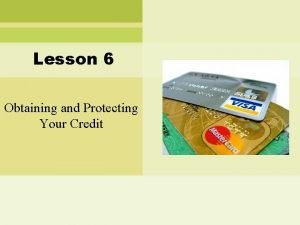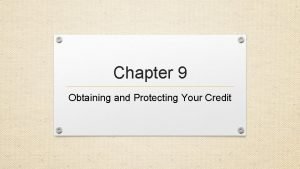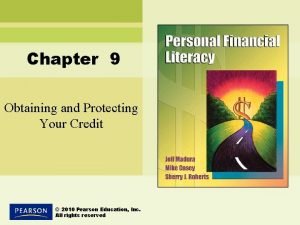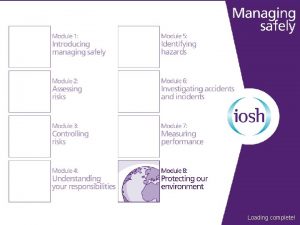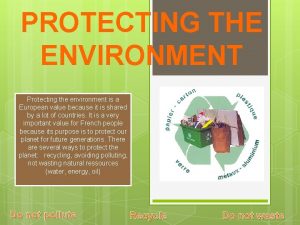Protecting your environment Personal Consumer Health 6 th








- Slides: 8

Protecting your environment Personal & Consumer Health 6 th Grade Objective 3. 1 & 3. 2

Warm Up #3 What do the 3 R’s stand for? ? ? *hint: they help keep our environment clean and less junk in the landfills.

What Can We Do

EPA: Environmental Protection Agency • Reducing & Reusing • The most effective way to reduce waste is to not create it in the first place. Making a new product requires a lot of materials and energy: raw materials must be extracted from the earth, and the product must be fabricated and then transported to wherever it will be sold. As a result, reduction and reuse are the most effective ways you can save natural resources, protect the environment, and save money.

Recycle Recycling- the process of collecting and processing materials that would otherwise be thrown away as trash and turning them into new products. • Steps to Recycling Materials • Step 1: Collection and Processing • After collection, recyclables are sent to a recovery facility to be sorted, cleaned, and processed into materials that can be used in manufacturing. Recyclables are bought and sold just like raw materials would be, and prices go up and down depending on supply and demand in the United States and the world. • Step 2: Manufacturing • More and more of today's products are being manufactured with recycled content. Common household items that contain recycled materials include: newspapers and paper towels; aluminum, plastic, and glass soft drink containers; steel cans; and plastic laundry detergent bottles. Recycled materials are also used in new ways such as recovered glass in asphalt to pave roads or recovered plastic in carpeting and park benches. • • • Step 3. Purchasing New Products Made From Recycled Materials

Benefits of Reducing Waste • Prevents pollution caused by reducing the need to harvest new raw materials; • Saves energy • Reduces greenhouse gas emissions that contribute to global climate change; • Helps sustain the environment for future generations; • Saves money • Reduces the amount of waste that will need to be recycled or sent to landfills and incinerators; • Allows products to be used to their fullest extent.

Composting • Composting – Composting is nature's process of recycling decomposed organic materials into a rich soil known as compost. • Food scraps and yard waste currently make up 20 to 30 percent of what we throw away, and should be composted instead. • Browns - This includes materials such as dead leaves, branches, and twigs. . • Greens - This includes materials such as grass clippings, vegetable waste, fruit scraps, and coffee grounds

Landfill Harmonic https: //www. youtube. com/watch? v=s. Jxxd. Qox 7 n 0
 Tertiary and secondary consumers
Tertiary and secondary consumers What is noninstallment credit
What is noninstallment credit Chapter 9 obtaining and protecting your credit
Chapter 9 obtaining and protecting your credit Chapter 9 obtaining and protecting your credit
Chapter 9 obtaining and protecting your credit Omnivore desert animals
Omnivore desert animals Consumer diversity in consumer behaviour
Consumer diversity in consumer behaviour Consumer research in consumer behaviour
Consumer research in consumer behaviour Consumer markets and consumer buyer behavior
Consumer markets and consumer buyer behavior Business buyer behavior refers to the
Business buyer behavior refers to the

